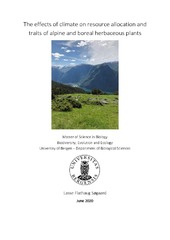The effects of climate on resource allocation and traits of alpine and boreal herbaceous plants
Master thesis
Permanent lenke
https://hdl.handle.net/1956/22996Utgivelsesdato
2020-06-26Metadata
Vis full innførselSamlinger
- Master theses [257]
Sammendrag
Climate is rapidly changing, and species are expected to change their ranges to where conditions are now more suitable. Which lowland species that range shift into alpine environments could have potentially different effects of biodiversity and ecosystem functioning. The potential effect of range shifts is dependent on resource allocation and trait response as these can affect the biotic interactions when species meet in a new environment. Furthermore, precipitation has the potential to enhance or mitigate the dynamic between competition and facilitation. This study was conducted along a natural temperature and precipitation gradient in western Norway, six species was sampled. Three sets of species groups were collected along the precipitation gradient, one set of alpine species, one set of lowland species with trait values similarly conservative as in the alpine community (‘extant’) and the other set of lowland species with more acquisitive trait values than common in alpine communities (‘novel’). I found that novel species are generally taller and have a higher biomass compared to the alpine species. In addition, the effects of precipitation on aboveground biomass, vegetative height and number of leaves was generally negative and response varied between the species groups. Moreover, allocation to aboveground decreased in both extant species. Gaining further knowledge on how potential competitor-identity and eventual interactions is important for further predicting how climate change and the indirect effects influence alpine communities.
